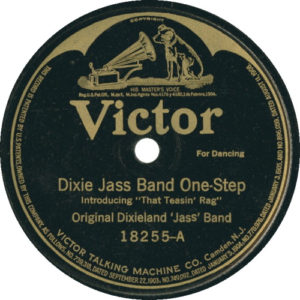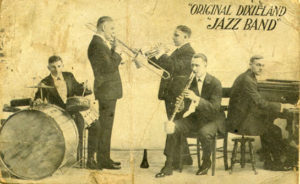 Victor 18255-A, the first jazz record, was cut in New York one hundred years ago yesterday, five years after the word “jazz” first appeared in print. On it, the Original Dixieland Jass Band, a group of five white musicians from New Orleans, can be heard playing Dixie Jass Band One-Step and Livery Stable Blues, a pair of more or less original tunes.
Victor 18255-A, the first jazz record, was cut in New York one hundred years ago yesterday, five years after the word “jazz” first appeared in print. On it, the Original Dixieland Jass Band, a group of five white musicians from New Orleans, can be heard playing Dixie Jass Band One-Step and Livery Stable Blues, a pair of more or less original tunes.
Contrary to the claims of Nick LaRocca, the band’s cornet player, the ODJB didn’t “invent” jazz—nobody did, really, least of all Jelly Roll Morton, who made the same claim—but its recordings played a pivotal role in popularizing and disseminating what soon came to be generally recognized as one of America’s first wholly original styles of music. As I wrote in Pops, my biography of Louis Armstrong:
The records made by the Original Dixieland Jazz Band…sound like jazz as we know it, primitive but recognizable, with the now-familiar front line of clarinet, cornet, and trombone playing the loosely woven, rough-and-ready counterpoint that would soon become known the world over. We have it on the best authority that they were recognized as such in their makers’ home town, for Louis Armstrong listened to “Livery Stable Blues” and “Tiger Rag” on his first phonograph, along with the opera arias whose Italianate ardor and showy virtuosity also left their mark on his style. “Between you and me, it’s still the best,” he wrote in Satchmo of the ODJB’s 1918 recording of “Tiger Rag.”
I rarely listen to the ODJB’s records for pleasure, and when I do, I’m more likely to opt for the electrically recorded remakes of its acoustic 78 sides that the band cut in 1936, which are much clearer-sounding and closely similar in style to the originals. Nevertheless, I do get pleasure out of them, for they are raucously vivid and vital souvenirs of jazz when it was still fresh from the cradle.
Nor do I lose any sleep over LaRocca’s oft-quoted, patently preposterous claim that “the Negroes learned to play this rhythm and music from the whites,” which is reflexively trotted out whenever the ODJB’s name is mentioned by those who are more interested in politics than music. LaRocca was, of course, talking through his hat—but what of it? The inescapable fact remains that the ODJB, for whatever reason or reasons, made it into the studio before anybody else, and the records they cut there were more than good enough to open the ears of the world.
A century later, jazz is no longer a popular music, a fact about which I wrote to controversial effect in 2009:
As late as the early ’50s, jazz was still for the most part a genuinely popular music, a utilitarian, song-based idiom to which ordinary people could dance if they felt like it. But by the ’60s, it had evolved into a challenging concert music whose complexities repelled many of the same youngsters who were falling hard for rock and soul. Yes, John Coltrane’s “A Love Supreme” sold very well for a jazz album in 1965—but most kids preferred “California Girls” and “The Tracks of My Tears,” and still do now that they have kids of their own.
 That’s as true today as it was eight years ago, La La Land and Whiplash notwithstanding, and I don’t expect the situation to change in my lifetime. Be that as it may, jazz—great jazz—is still being played in New York and all over the world, and I don’t expect that to change any time soon, either.
That’s as true today as it was eight years ago, La La Land and Whiplash notwithstanding, and I don’t expect the situation to change in my lifetime. Be that as it may, jazz—great jazz—is still being played in New York and all over the world, and I don’t expect that to change any time soon, either.
I was a professional jazz musician once upon a time, and my involvement in jazz continues to this day, albeit as a journalist, biographer, and playwright rather than a performer. Hardly a day goes by on which I don’t listen to at least one jazz record, usually on my MacBook, to which I have uploaded thousands of the performances I love best. I have no “favorite” kind of music, but I simply can’t imagine a world without the particular kind of music to which I have happily devoted so much of my life.
As Philip Larkin said of the records of Sidney Bechet, one of the first great jazz musicians:
On me your voice falls as they say love should,
Like an enormous yes. My Crescent City
Is where your speech alone is understood,
And greeted as the natural noise of good,
Scattering long-haired grief and scored pity.
Blessings, then, on the members of the Original Dixieland Jass Band, who first spoke the enormous yes of jazz into the horn of a recording machine. We have been in their debt for a century now. May we remain so throughout the century to come.
* * *
The surviving members of the Original Dixieland Jazz Band recreate their first recording session in a 1937 March of Time newsreel:
Eddie Edwards and Tony Sbarbaro, the original trombonist and drummer of the Original Dixieland Jazz Band, appear as guests on an episode of I’ve Got a Secret originally telecast on CBS on November 9, 1960. Their “secret” was that they had made the first jazz record in 1917. (Sbarbaro subsequently changed his last name to “Spargo.”) After stumping the panel, they play “Original Dixieland One-Step” with Phil Napoleon, Tony Parenti, and J. Russel Robinson, all of whom worked with the band at various times:
